Old man Cactus (Cephalocereus Senilis Succulent) Care
Written by Iris
Sep 22 2021
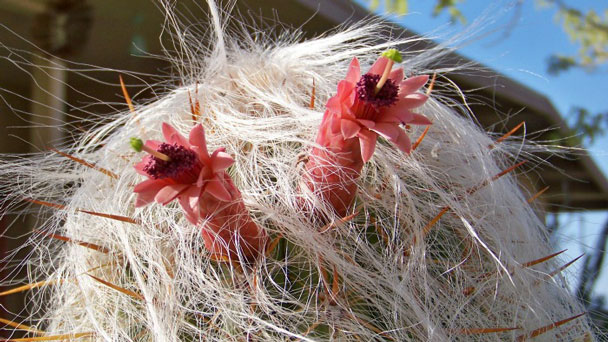
Old Man Cactus (Cephalocereus senilis) resembles an old fluffy old man and is sure to bring a lot of character to your juicy collection. This strange succulent plant comes from Guanajuato and Hidalgo in Mexico. Old Man Cactus is a long column that can grow up to 20 feet in the wild. But when you grow its cuttings or seeds in containers, Old Man Cactus can be limited in size for indoor use.
Most of the time, this can be accomplished by gently uprooting one or more offsets from the clump. You can use your hands, as long as you wear protective clothing, or you can cut the roots with a sharp, clean knife.
Once you’ve separated the offsets, allow them to dry out in the open air for several days. When you break or cut them away from the mother Old Man Cactus plant, you’re introducing open wounds, which are at risk of infection by bacteria or fungi.
The drying process allows those open wounds to callous, which will help prevent infection and give the offsets a better chance of survival.
Once the cuts have calloused, you can safely plant the offsets in new containers. After they've been transplanted, caring for the offsets is as simple as caring for mature Old Man Cactus.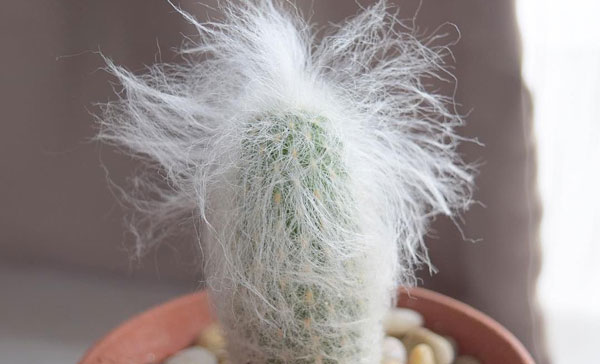
Though this cactus prefers as much sunlight as possible, it’s still best to slowly increase light levels if you’re moving the plant outdoors from an indoor location such as your home or a nursery.
If you expose your Old Man Cactus (Cephalocereus senilis) to too much light too soon, it could get sunburned despite its protective coating. Slowly increase light over a period of several weeks to safely allow the plant to adjust.
On the other hand, some indoor spaces won’t be able to provide enough light. Signs of inadequate light levels include a thin stem and discoloration.
If your indoor space doesn’t provide enough light for cephalocereus senilis, you can always supplement with artificial light. Grow lights are a great way to provide indoor plants with more light without breaking the bank.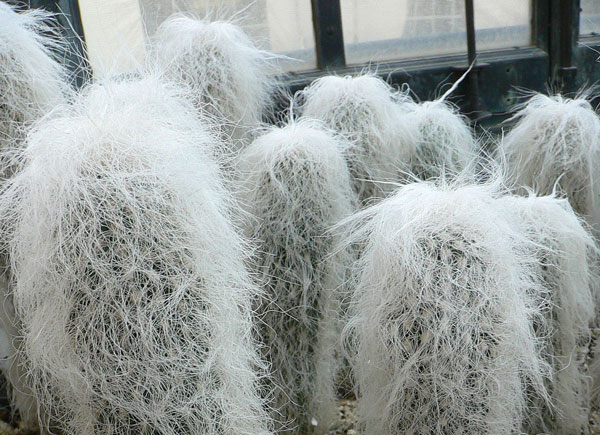
Detecting white, fuzzy pests like mealybugs or the webs of spider mites can be especially difficult, so it's important to examine your Old Man Cactus plant closely if you suspect an infestation.
Fortunately, dealing with pests on Old Man Cactus isn't any more difficult than treating the problem on other cacti. This is especially true if you can catch the infestation in its early stages.
However, if you're applying a topical treatment to the Old Man Cactus, you’ll need to be sure that the treatment is reaching the Old Man Cactus (Cephalocereus senilis) itself and isn't just sitting atop the hair.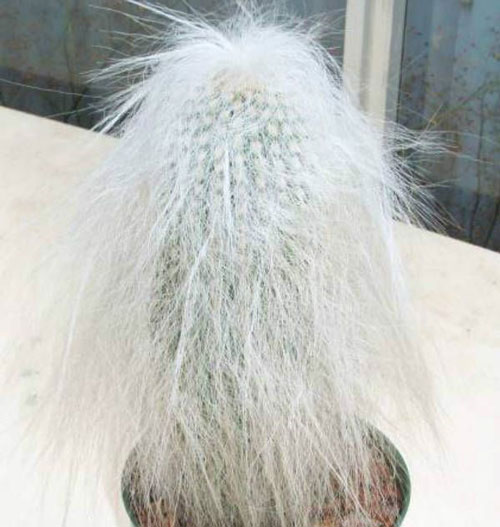
Cephalocereus senilis, also called Old Man Cactus, Bunny Cactus, or White Persian Cat Cactus, is a columnar cactus native to Mexico, especially Guanajuato and Hidalgo. This succulent species has distinctive long white hair covering the cylindrical, light to bright green stem.
Cephalocereus hoppenstedtii
Cephalocereus hoppenstedtii, known also as Cephalocereus columna-trajani or torch cactus, is a columnar arborescent cactus that can reach 6 to 10 m height. This Cephalocereus species has a slender, cylindrical stem with 16-20 ribs hidden under numerous spines.
Cephalocereus palmeri
Cephalocereus palmeri, also named Hairy Cereus Tree Cactus, is a beautiful cactus native to Eastern Mexico. This cactus tree has a slender stem which is greenish when young, then taking on a more bluish tint which contrasts well with the white bristles.
Cephalocereus lanuginosus
Cephalocereus lanuginosus is a stunning cactus native to northern South America and the Caribbean. This cactus has a columnar green-blue stem with slender branches. Also, the stem has golden-yellow spines that turn grey with age. Because of its upright growth, it is great for indoors and doesn't take up much space.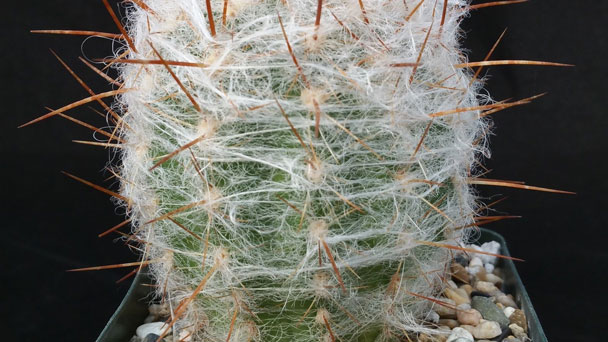
Rinse the Old Man Cactus (Cephalocereus senilis) under tepid running water to wet the hairy spines. Avoid hot or cold water as this will stress your cactus.
Lather with a mixture of Castile soap and water working it gently over all the hairs with your hands.
Rinse the soap away under running water, using care to remove all the soap residue.
“Comb” the hairs with your hands so that they help upward and away from the body of the cactus. Place the cactus in a warm, well-ventilated area where it will dry quickly. If necessary, use a fan to circulate air in the room and speed drying.
Where to Grow Old Man CactusHow to Grow Old Man Cactus (Cephalocereus senilis)Old Man Cactus Propagation with SeedsOld Man Cactus Propagation with CuttingsOld Man Cactus Propagation with OffsetsHow to Care for Old Man Cactus (Cephalocereus senilis)Old Man Cactus Light CareOld Man Cactus Soil CareOld Man Cactus WateringOld Man Cactus Temperature & Humidity CareOld Man Cactus Fertilizer CareOld Man Cactus Pruning CareOld Man Cactus Pests & Diseases Varieties of Cephalocereus senilisOld Man Cactus (Cephalocereus senilis) FAQHow to Grooming Your Old Man Cactus?Is Cephalocereus Senilis Toxic for Cats and Dogs?Does Old Man Cactus Produce Flowers?
Where to Grow Old Man Cactus
Old man cactus (Cephalocereus senilis) is not cold hardy, so if you live in a zone that gets colder than 30° F (-1.1° C), it's best to plant this succulent in a container that can be brought indoors. Plant in an area of your garden that gets 6 hours of sunlight a day.How to Grow Old Man Cactus (Cephalocereus senilis)
Old Man Cactus Propagation with Seeds
Propagating Old Man Cactus from the seed is fairly simple, bet requires a lot of patience. You can collect the seeds from an old man cactus flower, or purchase them from a reputable dealer. The important thing is providing a well-draining soil, and a grow light or a heated seed mat. Growing the seed can also serve as a fun project for children. We recommend doing this in May.Old Man Cactus Propagation with Cuttings
If you do not have enough time to wait, you can simply plant an Old Man Cactus cutting in a suitable pot with the right soil. But before actually planting the cutting, lie it out on the surface in a dry location for a few f days to callus. After this time, plant it in dry sand or perlite. Place the cutting in moderate light with at least 70 °F (21 °C) temperature for best rooting. Do not water the Old Man Cactus cutting until it has rooted. After that, care for it like a mature plant.Old Man Cactus Propagation with Offsets
Removing offsets is the easiest method of Old Man Cactus propagation. These cacti naturally grow in clumps, so it’s generally just a matter of gently separating individual cacti.Most of the time, this can be accomplished by gently uprooting one or more offsets from the clump. You can use your hands, as long as you wear protective clothing, or you can cut the roots with a sharp, clean knife.
Once you’ve separated the offsets, allow them to dry out in the open air for several days. When you break or cut them away from the mother Old Man Cactus plant, you’re introducing open wounds, which are at risk of infection by bacteria or fungi.
The drying process allows those open wounds to callous, which will help prevent infection and give the offsets a better chance of survival.
Once the cuts have calloused, you can safely plant the offsets in new containers. After they've been transplanted, caring for the offsets is as simple as caring for mature Old Man Cactus.

How to Care for Old Man Cactus (Cephalocereus senilis)
Old Man Cactus Light Care
As you might imagine, the Old Man Cactus needs lots of sunlight to thrive. They do best in full sun when planted outdoors. When grown indoors, they need as much light as they can get. A south- or west-facing window is ideal.Though this cactus prefers as much sunlight as possible, it’s still best to slowly increase light levels if you’re moving the plant outdoors from an indoor location such as your home or a nursery.
If you expose your Old Man Cactus (Cephalocereus senilis) to too much light too soon, it could get sunburned despite its protective coating. Slowly increase light over a period of several weeks to safely allow the plant to adjust.
On the other hand, some indoor spaces won’t be able to provide enough light. Signs of inadequate light levels include a thin stem and discoloration.
If your indoor space doesn’t provide enough light for cephalocereus senilis, you can always supplement with artificial light. Grow lights are a great way to provide indoor plants with more light without breaking the bank.
Old Man Cactus Soil Care
Different types of old man cactus prefer well-draining soil, like pre-made cactus soils or a mixture of sand, perlite, and suitable soil for cacti. There are many people who also grow Old Man Cactus cutting or seed in natural terra cotta pots. Since these pots let the water evaporate out the sides, and this plant prefers the soil on the dry side, it is another option for caring Old Man Cactus (Cephalocereus senilis).Old Man Cactus Watering
Before watering your Old Man Cactus (Cephalocereus senilis), make sure that the top two inches of its soil are dry. For irrigation in winter, the top couple of inches should be dry. This means that you only need to water it less than two times during winters. Be very careful and avoid over-watering, as it can make the roots of types of Old Man Cactus rot.Old Man Cactus Temperature & Humidity Care
Old Man Cactus (Cephalocereus senilis) is not a cold hardy plant. If you live in a climate with harsh winters, you will need to bring your cactus indoors until spring. This cactus is capable of surviving extreme heat, but it will not survive extreme cold. Generally, a light frost shouldn't be too much of a concern, but prolonged cold weather will be a problem. If you're expecting temperatures to drop below freezing, it’s best to keep your cactus protected. When grown indoors, there's not usually much to be concerned about in terms of temperature. The average temperature of most indoor spaces is usually adequate for the Old Man Cactus. However, it is helpful to avoid sudden drafts if possible.
Old Man Cactus Fertilizer Care
At the start of the growth period apply a dressing of slow-release fertiliser and stir it into the surface soil in the pot. Avoid splashing the hairs with fertiliser.Old Man Cactus Pruning Care
Old Man Cactus (Cephalocereus senilis) almost needs zero pruning, since it slowly grows in a straight line. And thanks to its dense hairs, it is protected against both heat and cold, while retaining the desired moisture. What you can do, is an occasional spray of water, combing the hair to clean any dust and insects; and of course, so that your old man looks well-trimmed.Old Man Cactus Pests & Diseases
Old Man Cactus isn't any more prone to common succulent pests than any other species of cactus, but it can be more difficult to detect pests because of the hair. While it would be nice if pests lived on the outside of the hair, so they'd be easier to see, that's not where the food source is. When checking your Old Man Cactus for pests, you'll need to cautiously search under the hair while avoiding the sharp spines hidden among the fluff.Detecting white, fuzzy pests like mealybugs or the webs of spider mites can be especially difficult, so it's important to examine your Old Man Cactus plant closely if you suspect an infestation.
Fortunately, dealing with pests on Old Man Cactus isn't any more difficult than treating the problem on other cacti. This is especially true if you can catch the infestation in its early stages.
However, if you're applying a topical treatment to the Old Man Cactus, you’ll need to be sure that the treatment is reaching the Old Man Cactus (Cephalocereus senilis) itself and isn't just sitting atop the hair.

Varieties of Cephalocereus senilis
Cephalocereus senilisCephalocereus senilis, also called Old Man Cactus, Bunny Cactus, or White Persian Cat Cactus, is a columnar cactus native to Mexico, especially Guanajuato and Hidalgo. This succulent species has distinctive long white hair covering the cylindrical, light to bright green stem.
Cephalocereus hoppenstedtii
Cephalocereus hoppenstedtii, known also as Cephalocereus columna-trajani or torch cactus, is a columnar arborescent cactus that can reach 6 to 10 m height. This Cephalocereus species has a slender, cylindrical stem with 16-20 ribs hidden under numerous spines.
Cephalocereus palmeri
Cephalocereus palmeri, also named Hairy Cereus Tree Cactus, is a beautiful cactus native to Eastern Mexico. This cactus tree has a slender stem which is greenish when young, then taking on a more bluish tint which contrasts well with the white bristles.
Cephalocereus lanuginosus
Cephalocereus lanuginosus is a stunning cactus native to northern South America and the Caribbean. This cactus has a columnar green-blue stem with slender branches. Also, the stem has golden-yellow spines that turn grey with age. Because of its upright growth, it is great for indoors and doesn't take up much space.

Old Man Cactus (Cephalocereus senilis) FAQ
How to Grooming Your Old Man Cactus?
Due to its hairy nature, your Old Man Cactus may collect dust and other airborne particles in its hair causing it to discolor or look dull. Fortunately, this is easy to fix with a gentle shampoo. Here’s how:Rinse the Old Man Cactus (Cephalocereus senilis) under tepid running water to wet the hairy spines. Avoid hot or cold water as this will stress your cactus.
Lather with a mixture of Castile soap and water working it gently over all the hairs with your hands.
Rinse the soap away under running water, using care to remove all the soap residue.
“Comb” the hairs with your hands so that they help upward and away from the body of the cactus. Place the cactus in a warm, well-ventilated area where it will dry quickly. If necessary, use a fan to circulate air in the room and speed drying.
Is Cephalocereus Senilis Toxic for Cats and Dogs?
The website of the American Society for the Prevention of Cruelty to Animals (ASPCA) has declared Old Man Cactus as safe and non-toxic for cats and dogs.Does Old Man Cactus Produce Flowers?
Old Man Cactus (Cephalocereus senilis) produces flowers in the summer but only after 10 to 20 years. The flowers come from its cephalium which does not develop until the plant reaches maturity. This succulent’s whitish-yellow flowers measure 3-inches (8cm) long with a diameter of 2.75-inches (7cm) and are shaped like a trumpet. When in full bloom during the summer season, the flowers will be accompanied by fruits that are pinkish-red in color with yellowish hair and measure 0.8 to 1-inch (2-3cm) long.Latest Updated
- Benefits of Bugleweed - 7 Science-backed Health Benefits
- Bugleweed Dangers & Side Effects - Is It Poisonous?
- How to Plant Evergreen Trees - What You Should Know
- When to Plant Evergreens - Grow Guide for Evergreen Trees
- 12 Wonderful Evergreen Shrubs for Your Garden
- 12 Popular Evergreen Plants with Pictures for Beginners
- When And How To Prune A Lilac Bush Like a Pro
- How to Grow & Care for Lilac Vine (Hardenbergia Violacea)
- Japanese Lilac Tree (Syringa Reticulata) Care & Propagation Guide
- Shumard Oak Pros and Cons - What to Know
Popular Articles
- Winter maintenance of Antirrhinum Majus
- How to Grow Terminalia Mantaly Tree
- How to Grow and Care for Crossostephium Chinense
- How to grow Antirrhinum Majus in spring
- Peristeria Elata (Dove Orchid) Profile: Info & Care Guide
- Underwatered Snake Plant (Sansevieria Trifasciata) - Signs And How To Fix
- How to Care for Brazilian Jasmine Plant (Mandevilla Sanderi)
- How to Grow & Care for Graptopetalum Purple Delight in Summer
- Rosa Chinensis (China Rose): Plant Growing & Care Tips
- How to Care for Baby Sun Rose (Aptenia Cordifolia)